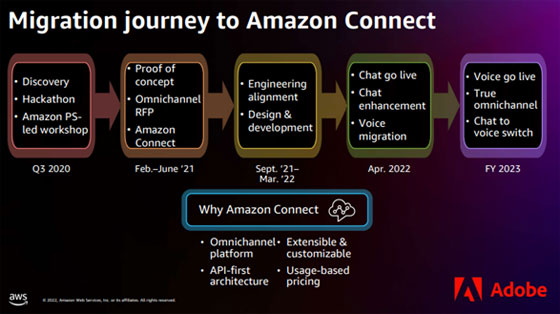With more than 50,000 attendees, AWS re:Invent returned, bigger than ever before.
At the event, AWS made many announcements relating to its Global Cloud Infrastructure.
Yet, notably, customer experience and contact center also played a leading role during the event – with Amazon Connect very much front and center.
Having continued its rise from a telephony-only solution to an end-to-end platform, AWS seemed keen to draw more attention to its CCaaS offering – which recently celebrated its fifth anniversary.
In doing so, it announced many trailblazing AI and machine learning-powered capabilities embedded into its new chat analytics, Agent Workspace, and capacity planning tools.
However, the stories of Amazon Connect users, who took to the re:Invent stage, were perhaps most intriguing as they shared their digital transformation initiatives.
Here are their stories, with some practical learnings scattered along the way.
Customer Story #1 Kentucky Transportation Cabinet Reimagines Agent Experiences with CCaaS
The Kentucky Transportation Cabinet’s mission is to provide a “safe, efficient, environmentally sound” transportation system for Kentucky citizens.
In meeting this mission, its contact center agents must handle many queries, from simple license renewals to more complex commercial vehicle permits and everything in between.
Yet, its on-premise platform disrupted this process. Moreover, its infrastructure complexity, lack of reliability, and unintuitive agent experience slowed down service teams.
As such, it kickstarted a CCaaS migration project, choosing Amazon Connect because AWS:
- Provided the organization with custom call center solutions
- Delivered a conversational AI application – across voice and digital channels
- Offered “a spirit of innovation” and an achievable product roadmap
For this migration, the Kentucky Transportation Cabinet split its plan into four stages: ideation, proof of concept, analysis, and production.
The business focused much of this ideation time on reimagining the agent experience.
Discussing this process, Drew Clark, Business Analyst at the Kentucky Transportation Cabinet, said:
[We] immediately started using its agent workspace to provide agents everything they need to resolve customer issues, access customer data, and knowledge repositories in a single application, without writing any code.
“By equipping our agents with tools like case management, ML-powered real-time knowledge recommendations, and customer profiles, we’ve been able to cut our average citizen wait time in half and cut agent training time by more than 50 percent.”
The business also implemented Amazon Connect’s case management tools, conversational analytics, and self-service applications as part of the migration – alongside its API system integrators.
In doing so, the Kentucky Transportation Cabinet automated 90 percent of live chat conversations, cut its average handling time from over five minutes to 3.3 minutes, and reduced agent onboarding time from four to two weeks.
Yet, in terms of his top takeaways from the project, Clark put forward the following five-step process for kicking off a CCaaS migration with AWS.
- Identify the outcomes you want to drive for your contact center
- Dive deep into Amazon Connect agent experience capabilities and extensibility
- Get assistance from solution architects/AWS ProServe/AWS Partners to build a PoC
- Pilot services for smaller workloads; a good starting place is employee self-help desks
- Expand to customer-facing workloads
Delve deeper into this customer story and five-step process by watching the video below.
Customer Story #2 Fujitsu Migrates 150 Service Desks to the Cloud
Fujitsu is a global leader in PCs, servers, and IT services. It supports 150 service desks in six countries and 40 languages to satisfy the needs of its worldwide customer base.
Yet, modernizing these service desks proved challenging, with innovation programs stuck in a complex swamp of legacy systems.
Meanwhile, license and support costs were ramping up – making a CCaaS switch more alluring.
Ultimately, Fujitsu migrated to Amazon Connect, thanks partly to its pricing scheme (per usage) and “next-generation” capabilities – including call analytics, AI/ML-powered automation, and open-sourced integration.
Indeed, Amazon Connect’s “out of the box” APIs allowed Fujitsu to connect its contact center with ServiceNow’s ITSM tools. Yet, Fujitsu’s ambitions expanded far beyond this.
As Alex Sanchez, Head of Global Offering Technology and GDC Networks at Fujitsu, said:
We needed to build more than a platform. We needed to build an entire ecosystem.
To do so, Sanchez’s team created a building block design, establishing four cornerstone focuses to kickstart their migration. These included:
- A Dynamic IVR – With this application, Fujitsu harnesses skill-based routing, flow design, and a CTI integration alongside many more advanced IVR capabilities. The organization may also track real-time and historical metrics to measure its progress.
- Third–Party Data Integration – Using integrations that extend beyond the internal contact center, operations could bring in data through new sources – such as its enterprise ServiceNow ITSM solution – to power new CX strategies.
- AI and Machine Learning – With its ServiceNow integration, Fujitsu enables many agent workflow automations – alongside virtual agent and real-time translation deployments.
- Security Improvements – By accessing the identity and access management modules within AWS and integrating these with its Azure Active Directory, Fujitsu bolstered its security.
“We built an entire ecosystem. With Amazon Connect at the center, we could take this into Amazon Quicksight, S3, Lex, Lamda, and Kinesis,” added Sanchez.
As a result, his team reduced operational costs by 50 percent, call recording costs by 80 percent, and cut the manual effort of building complex contact flows from 20 to two hours.
Learn more about how Fujitsu achieved these results by watching the video below.
Customer Story #3 Adobe Begins Its Digital-First CCaaS Migration with a Hackathon
With 26,000+ employees in 35 countries, Abode’s service operations are steeped in complexity, handling contacts from enterprises, SMBs, and consumers.
In taking on this challenge, it struggled with frequent platform outages and disjointed experiences, with no context following customers as they switched between channels.
Ready for a change, Adobe migrated to the cloud, citing the following motivations:
- Migrate to an innovative omnichannel CCaaS solution
- Deliver personalized experience through AI & ML and connect all data sources
- Align with CX priorities to drive engagement and retention
It also strived to select a partner to meet its needs in “innovation, flexibility, and scale.”
In doing so, Adobe put together the following migration timeline:

Adding color to the timeline, Vikas Sagas, Manager of Engineering at Adobe, said: “We started with a discovery phase, compiling all of our business requirements and understanding what solutions are available within the market.”
As a result of this discovery phase, we hosted a quick three-day hackathon, led by the AWS professional services team, to evaluate Amazon Connect as our omnichannel solution. It was a huge success and helped us build confidence that we were heading in the right direction.
From there, it built an end-to-end proof of concept (PoC), integrating Amazon Connect with its custom chat client and other back-end services.
Sagas described the rest of the migration process as “smooth” – thanks to the CCaaS platform’s extensibility – and revealed many impressive outcomes. These included: increased reliability (no major platform outages) and scalability, alongside enhanced customer and employee experiences.
Learn more from Sagas, dig deeper into these outcomes, and find out Adobe’s latest contact center innovation plans by checking out their presentation below.
Catch Up On re:Invent 2022
Alongside the presentations from Kentucky Transportation Cabinet, Fujitsu, and Adobe, re:Invent had many more fascinating customer stories and content for contact center leaders.
Indeed, the event showcased AWS’s latest Amazon Connect features, AI capabilities, and thought leadership – with something for every CX leader.
To delve into all this content, visit the AWS Events YouTube Channel. .
Or, for a closer inspection of Amazon Connect, visit: aws.amazon.com/connect/







